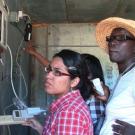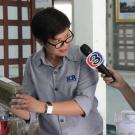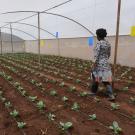Innovative technologies for horticultural development
Tested, adapted, promoted by the Horticulture Innovation Lab
Scientists with the Horticulture Innovation Lab are testing and adapting a range of technologies aimed at significantly improving the profitability of fruit and vegetable production throughout the world. Given the complexity of horticulture, technologies such as these can reduce constraints that limit the ability of smallholder farmers to achieve maximum profitability with high-value horticultural products. Our goal is to develop and test technologies that can overcome common limitations in land, labor, capital and infrastructure.
Problem: Postharvest losses
In much of the developing world, rates of postharvest loss exceed 50 percent, and cold storage is virtually non-existent due to the high cost of equipment and limited electricity. Quickly cooling produce after harvest extends shelf life by reducing metabolic activity, water loss and microbial growth. Farmers who can store their produce longer can access better prices, as market prices fluctuate.
The CoolBot:
- Converts an insulated room and an inexpensive, readily available window air conditioner into a coolroom.
- Substantially reduces the cost of cool storage for horticultural produce.
- Overrides the air conditioner’s temperature gauge, maximizing cooling power.
- Makes cold storage a viable option for developing-world farmers, cooperatives and market groups to increase their competitiveness.
See more information about the Coolbot
Problem: Insect pest damage
Insect pests reduce yields directly by attacking crops and indirectly by transmitting viral diseases. As a result, farmers sell damaged produce or use high levels of pesticides, which can be dangerous to both farmers and consumers. Small-scale growers rarely have access to training on effective pesticide use or alternative methods of pest control, such as integrated pest management.
Pest-exclusion nets:
- Provide an inexpensive, reusable and safe method of managing insect pests.
- Create a barrier that protects vegetables against pests and associated viral diseases, and improves temperature, light, relative humidity and soil moisture.
- Increase yields and improve vegetable quality, while reducing the reliance on pesticides that impact environmental and human health.
- Are produced locally by mosquito net factories.
- Increase market opportunities for domestically produced textiles.
See more information about pest-exclusion nets
Problem: Poor seed quality
In tropical climates, high humidity causes rapid seed deterioration that results in poor stand establishment, lower productivity, reduced market value and a disincentive to invest in improved seeds.
Drying beads:
- Provide a widely adaptable method for drying seeds and are reusable.
- Maintain high seed quality during storage.
- Lead to higher germination rates and increased yield capacity.
- Increase farmer incentive to invest in improved cultivars.
- Can be integrated with local seed systems to increase market for local and improved cultivars.
See more information about drying beads



